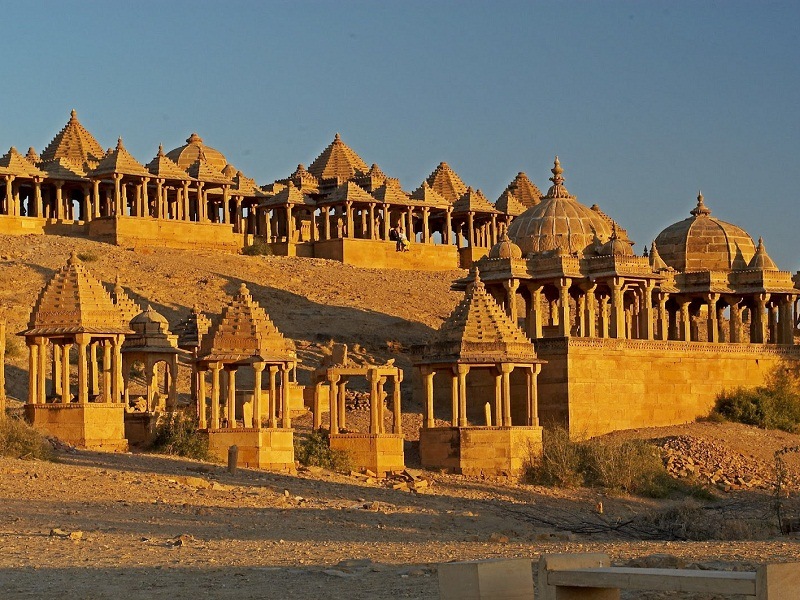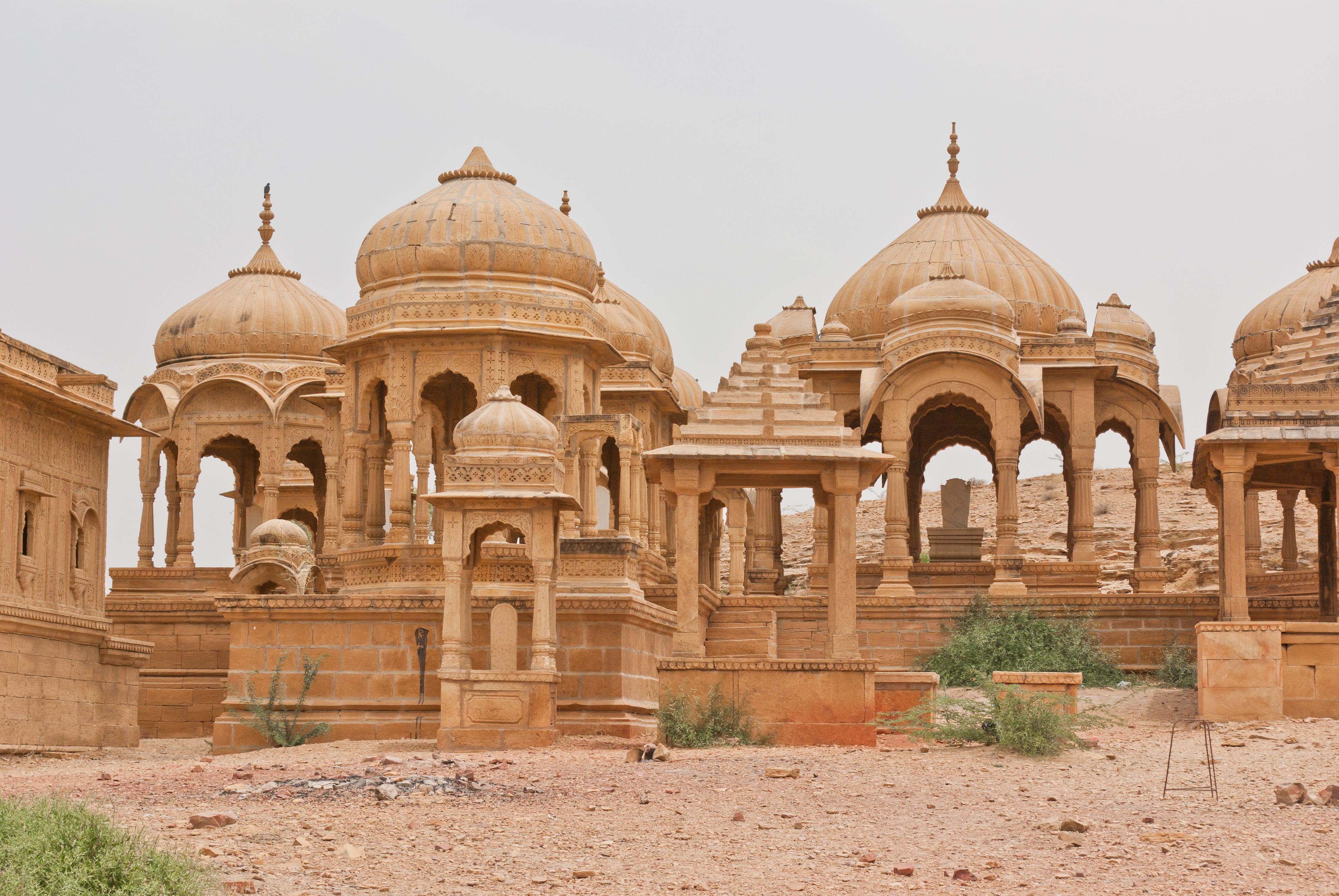Equidistant from Jaisalmer and Lodhruva, Bada Bagh, literally meaning big garden, features a series of royal cenotaphs or chhatris of Jaisalmer Maharajas, including that of Jai Singh II (Maharaja Sawai Jai Sing). The first cenotaph in the region was built for Jai Singh II by his son, Lunkaran, in the 16th century. Jai Singh II was known for his contribution to making the city green. And to honor him, his son set up a memorial in the form of cenotaph near the dam and created a big park around it. All the cenotaphs here have a beautifully carved ceiling and elegant equestrian statues of rulers. The location of the garden is such that it offers incredible sunset vistas to tourists.
When on a trip to Bada Bagh, tourists should visit the garden, tank, and dam. Jait Bandh, the dam, dominates the region. Next to Bada Bagh is the Bhaironji Temple, which is often visited by childless women and offer silver girdles to a deity in a hope to cure their infertility. Bada Bagh is not too far from Jaisalmer Fort; one can rent a car to reach the place.
At a distance of 8 km from Jaisalmer Railway Station and 7 km from Jaisalmer Fort, Bada Bagh or Bara Bagh is a historical garden located on Ramgarh road and halfway between Jaisalmer and Lodurva in Rajasthan.
Bada Bagh means big garden. It is a garden of cenotaphs or chhatris of the royal family of Jaisalmer. A descendant of Maharawal Jaisal Singh, Jait Singh II, commissioned a dam to create a water tank in the 16th century AD. This made the desert green in this area. After his death, Bada Bagh was fully developed by his son Lunakaran.
The garden stands at the foot of a hill and several chhatris or cenotaphs stand in memory of the late rulers of Jaisalmer. Cenotaphs are also known as chhatris and one cenotaph is erected for each ruler. The cenotaph of Maharawal Jait Singh is the oldest of all. Many cenotaphs were built by subsequent rulers for the Bhatti royal family of Jaisalmer. This continued till the 20th century when the last one for Maharawal Jawahar Singh was left incomplete as his son who ascended the throne after him, died within one year of his ascension. This was considered to be bad luck and from then on, the tradition of cenotaphs at Bada Bagh was discontinued.
The architecture of these chhatris is a blend of Paliwal, Mughal, and Rajput styles of architecture. Each cenotaph contains inscribed tablets with names of the King and Queen. Some of the cenotaphs have a statue of the King on a horse along with his queen standing nearby. The size of the chhatri varies according to the status of the person.
This garden also includes a tank and a dam, along with a Govardhan Stambh (pillar). The pillar was constructed for commemorating the construction of the nearby tank and dam. Locals refer to the dam as Jait Bandh, while the tank is known as Jait Sar. The Jait Bandh is a huge structure measuring over 1,200 feet in length and 350 feet in width. Both the tank and dam has been constructed using solid blocks of stone.
About Bada Bagh

Located at an equal distance both from Lodhruva and Jaisalmer, Bada Bagh is one of the most significant relics of our country. Featuring a series of cenotaphs, Bada Bagh portrays illustrious past of Rajasthan. Gleaming through the desert regions of Jaisalmer, Bada Bagh once was wrapped within a coat of lush green gardens. The famous golden cenotaphs at Bada Bagh are located at a distance of 6 km from the northern region of Jaisalmer.
According to the Hindu literature, the term ‘Bada Bagh’ signifies a big garden. While the structure was first constructed, it had a beautiful garden encircling it. This might be the reason as to how and why the place came to be known as Bada Bagh. Perhaps today, you won’t mark the presence of any garden there. But for sure, the site is quite peaceful with golden cenotaphs arising from the golden stretch of land. It has been said that every single cenotaph here is honored to be constructed in the memory of either a king or a queen from the royal family that stayed here.
These cenotaphs are nothing but tomb shaped structures which are locally referred to as Chhatris. The art of constructing Chhatris began somewhere around the 17th century and lasted until the 20th century. The first cenotaph that marked its presence here was erected as a tribute to the Maharaja Jai Singh II. After that, different Chhatris were constructed, which differ widely in their sizes.
Today, you could see them standing tall in two rows reflecting the power quotient and the social status of the members of the Royal family. If you look closely at the top of each Chhatri, there’s a small stone inscription there with the date and the name of the person to whom it has been commemorated. Very few of them have brief descriptions, as well.
History of Bada Bagh

The credit for the construction of this piece of land goes to the Maharaja Maharawal Jai Singh. He started his work by constructing a dam in the desert region so that it could serve the purpose of a water tank for the nearby villages. Soon, the water from this dam brought unparalleled glory to the entire periphery, and the region witnessed a surprising bloom in both its flora and fauna. This delighted every boon of efforts that Maharaja Maharawal Jai Singh invested into the construction of his venture.
With his death on 21st September 1743, it was his son to commemorate him with the construction of a Chhatri here. The creation of this commemorable structure in the immediate neighbor of the lake laid the foundation of a new tradition for all the Bhatti dynasty rulers. After that, to recognize and valor the contribution of each of its Bhatti dynasty rulers, a new cenotaph came to be constructed.
It was in the year 1947 when this tradition of cenotaph construction was discontinued on account of the sad demise of one of the princes who passed away after suffering from a mysterious disease. This death was considered to be a reflection of lousy omen amongst the Royals. Hence, they inanimate on the discontinuation of the tradition.
The Chattris at Bada Bagh

Bada Bagh witnessed a tradition of constructing Chattris somewhere around the 17th century, which lasted until the 20th century. The first Chattri or cenotaph, which came to be built here, was that of Maharaja Jai Singh II, who ruled the region between 1688 to 1743. He made immense contributions as a ruler during his reign in Jaisalmer. The major one was the dam construction, which was aimed at uplifting both flora and fauna in the community for the betterment of the society. After his death, his son decided to commemorate his valuable contribution towards social development by constructing a cenotaph near to this water body.
This laid the foundation of a new tradition in the Bhatti dynasty. Later, it was decided that upon the demise of every royal king and queen of the Bhatti dynasty, a new cenotaph would be constructed here in his or her memory. However, this tradition came to be discontinued by the mysterious demise of Maharaja Jawahar Singh. Every single chhatri at the Bada Bagh has got its own height and appear in two different rows.
They are built in such a way that each one reflects the power quotient of the ruler to which it has been associated with. In short, the more powerful a king or queen stood during his reign, the tall his Chhatri would stand. At the top of each Chhatri, there’s a stone inscription reflecting the date and the name of the king or queen to whom it has been honored to. On some of them, you would even witness a brief description, as well.
How to Reach Bada Bagh

Bada Bagh is located at a 6 km from the railway station of Jaisalmer as well as the city center. To reach Bada Bagh, you need to pass through an entrance located at the bottom of the hilltop, which displays the Bada Bagh on its top summit. As this is a very famous tourist attraction of Jaisalmer, you will easily find a cab or a rental vehicle to drop you to the foothills. Besides, there are regular bus services to transfer you between Ramgarh bus station and Bada Bagh, Jaisalmer.
Best Time to Visit Bada Bagh

The period between October to March is the best time to plan your visit to the Bada Bagh in Jaisalmer. Although, the afternoon may still be hot throughout this period but not as much as the sweltering extremities faced during other months.
Evenings are the most preferred time to plan your visit to Bada Bagh as the weather remains pleasant to a reasonable extent. The mixture of daylight transitions and a cold breeze blowing will keep you encouraged to explore the beautiful aura of the Bada Bagh’s cenotaphs.













9 Comments
Comments are closed.